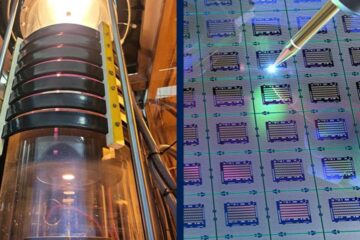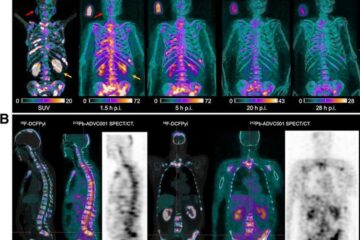Promising new tool shows how dividing cells finish what they start

Discovery highlights molecular screening work at Institute of Chemistry and Cell Biology
Boston, Mass. — Scientists studying how cells know when and where to divide now have a new tool to study the final fast stage of cell division. The first experiments using this new tool reveal some of the molecular conversation that helps a cell tightly choreograph the time and place of pinching into two cells. In the March 14 Science, researchers from Harvard Medical School (HMS) and colleagues report the discovery of a small compound called “blebbistatin” that blocks the final cleavage motion after cells have duplicated and separated their chromosomes.
Blebbistatin works by interfering only with a type of myosin necessary for the final stage of cell division, said HMS postdoctoral fellow Aaron Straight, first author of the paper. The final stages of cell division happens in mere minutes – too fast for scientific scrutiny. Other inhibitors that slow or stop cell contraction also damage other parts of the cell, obscuring molecular details. Blebbistatin appears to works with the precision of a scalpel, both freezing the action and preserving other molecules and functions for detailed study.
Myosin – the protein responsible for the contraction of muscle – is central to many aspects of human biology, including heartbeat, breathing and movement. Myosin mutations can cause heart disease, deafness, blood disorders and blindness. Myosin is also necessary for single cells to divide. Myosin is required for each and every cell division in the human body, beginning with one fertilized cell to the billions of cells in an adult, Straight said. Myosin also powers the movement of cells through the body, including immune cells that are trying to kill an invading pathogen and nerve cells seeking to make the proper connections in the developing brain.
Straight and his colleagues discovered more details about when and where the action of myosin is required in cytokinesis, the final stage of cell division. In one of two main findings, they showed for the first time in mammalian cells that a cell uses the same cellular machinery to finish as it uses to start division, which had been shown earlier in yeast. Specifically, when they blocked that machinery – proteosomes, which destroy key proteins as a necessary step in many cell functions – the cell was unable to complete cell division.
In the other finding, the researchers identified a few of the molecular details that the microtubules use to signal the time and location of cleavage between cells after they pull the duplicated chromosomes apart. The signals between the microtubules and the cell membrane diverge into two pathways, one that signals myosin and a second unknown pathway that positions another protein (anillin) needed for the final stage of cell division.
“A complex network of signaling from microtubules to the cell membrane tells the cell both when and where to divide,” Straight said. “The same thing that is pulling chromosomes apart is making sure that cells divide in the proper place so that the genetic material gets equally segregated into the two daughter cells.”
Blebbistatin was discovered by screening 17,000 small molecules in the chemical library of the HMS Institute of Chemistry and Cell Biology, co-directed by Timothy Mitchison, HMS Hasib Sabbagh professor of cell biology and co-author of the paper.
Co-authors include: Amy Cheung, visiting scientist from Merck; John Limouze, student, and James Sellers, chief of the Cell Motility Lab, both at the National Health Lung and Blood Institute; Irene Chen, student at Massachusetts General Hospital; and Nick Westwood, assistant professor of chemistry at University of St. Andrews, Scotland.
The work was supported by grants from the National Institutes of Health, Merck & Co., E. Merck, and the Cancer Research Fund of the Damon Runyon-Walter Winchell Foundation.
Harvard Medical School has more than 5,000 full-time faculty working in eight academic departments based at the School’s Boston quadrangle or in one of 47 academic departments at 18 affiliated teaching hospitals and research institutes. Those HMS affiliated institutions include Beth Israel Deaconess Medical Center, Brigham and Women’s Hospital, Cambridge Hospital, Center for Blood Research, Children’s Hospital, Dana-Farber Cancer Institute, The Forsyth Institute, Harvard Pilgrim Health Care, Joslin Diabetes Center, Judge Baker Children’s Center, Massachusetts Eye and Ear Infirmary, Massachusetts General Hospital, Massachusetts Mental Health Center, McLean Hospital, Mount Auburn Hospital, Schepens Eye Research Institute, Spaulding Rehabilitation Hospital, VA Boston Healthcare System.
Media Contact
More Information:
http://www.hms.harvard.edu/All latest news from the category: Life Sciences and Chemistry
Articles and reports from the Life Sciences and chemistry area deal with applied and basic research into modern biology, chemistry and human medicine.
Valuable information can be found on a range of life sciences fields including bacteriology, biochemistry, bionics, bioinformatics, biophysics, biotechnology, genetics, geobotany, human biology, marine biology, microbiology, molecular biology, cellular biology, zoology, bioinorganic chemistry, microchemistry and environmental chemistry.
Newest articles

Silicon Carbide Innovation Alliance to drive industrial-scale semiconductor work
Known for its ability to withstand extreme environments and high voltages, silicon carbide (SiC) is a semiconducting material made up of silicon and carbon atoms arranged into crystals that is…

New SPECT/CT technique shows impressive biomarker identification
…offers increased access for prostate cancer patients. A novel SPECT/CT acquisition method can accurately detect radiopharmaceutical biodistribution in a convenient manner for prostate cancer patients, opening the door for more…

How 3D printers can give robots a soft touch
Soft skin coverings and touch sensors have emerged as a promising feature for robots that are both safer and more intuitive for human interaction, but they are expensive and difficult…





















